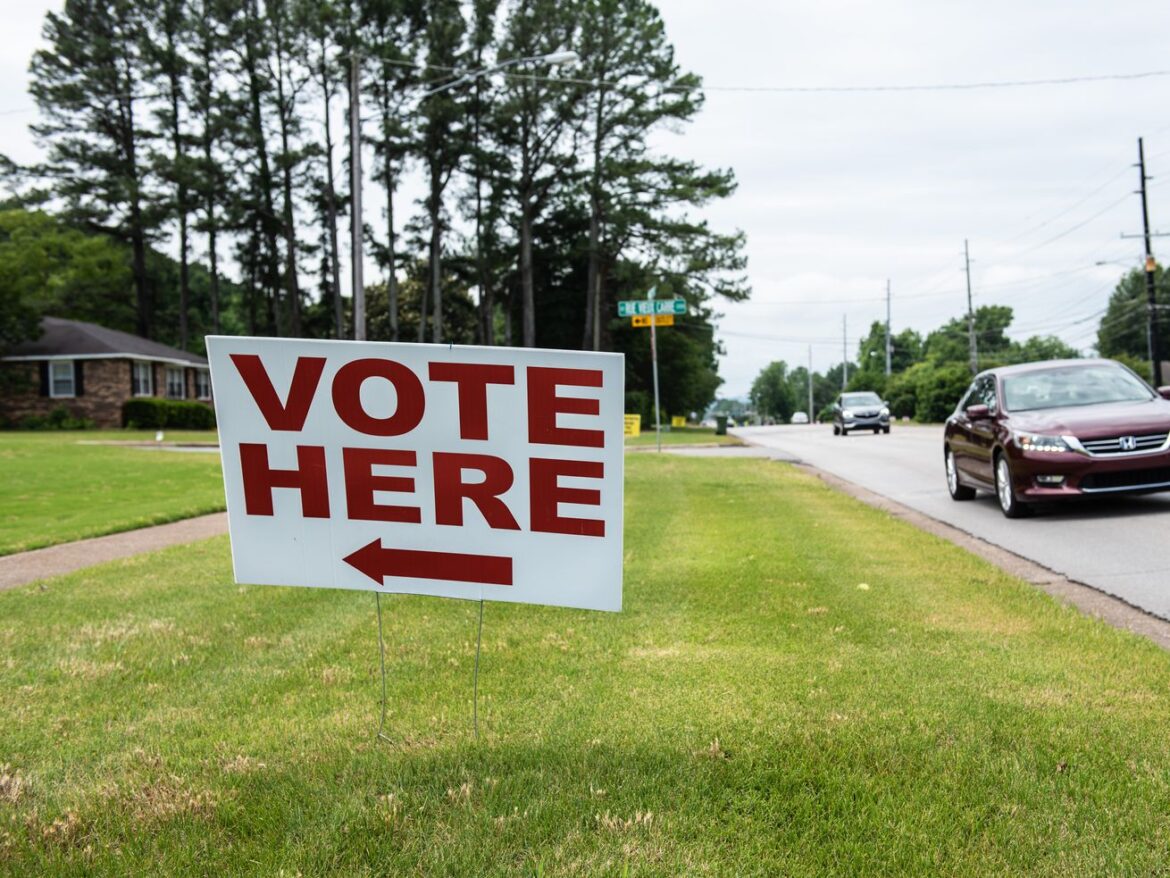Republicans in Alabama still want to dilute the Black vote.
The latest battle in the redistricting wars took another turn this week: On Tuesday, a panel of judges struck down Alabama’s latest congressional map since it did not follow a court order to comply with the Voting Rights Act.
The court’s decision is the latest in a war over a redistricting plan that could change the balance of power in the US House. The state had originally drawn a map in 2021 that denied Black voters the opportunity to elect a candidate of their choice in almost all of the districts, despite the fact that Black people make up 27 percent of the state’s voting-age population. In June, the Supreme Court, in Allen v. Milligan, upheld a trial court ruling striking down the map.
Then Alabama tried again — with a map that, like the 2021 version, still had only one district with a Black majority. According to the judges, Alabama was brazen in its attempt to move forward with the map: “The law requires the creation of an additional district that affords Black Alabamians, like everyone else, a fair and reasonable opportunity to elect candidates of their choice. The 2023 Plan plainly fails to do so.” The federal court has ordered a special master to draw three new potential maps to include two districts where Black voters can get the chance to elect candidates of their choice. The court will approve a new map in October.
Similar fights over congressional and legislative maps are playing out in states including Texas and Georgia. Alabama has already announced its plan to appeal the ruling.
I talked to Michael Li, counsel at the Brennan Center, an organization that tracks voting rights laws and violations, about what is next in the war and what it all means for next year’s elections and voters nationwide.
Fabiola Cineas
Why did a panel of three federal judges strike down Alabama’s latest congressional redistricting plan?
Michael Li
Alabama gave a middle finger to an earlier ruling of the district court and of the Supreme Court, which ordered it to create a second Black congressional district. Alabama failed to do that and admitted that it failed to do that. What Alabama did is reminiscent of George Wallace standing at the door of the schoolhouse back in the 1960s. The federal court’s order was very clear that Alabama needed to create a second district that was either majority black or something quite close to it. Instead, Alabama drew one district to be 40 percent Black and said, “Well, it’s close enough.” The reality is, given how racially polarized voting is in Alabama, a 40 percent Black district just is not Black enough to give Black voters a chance to win elections.
The state admitted that, arguing that Black voters win elections and said that was the best the state could do. In the opinion of the three-judge panel, they said it’s clear the state didn’t even try. Most of the time, states do kind of try by saying something like Black voters win five out of 10 elections, something like that, but Alabama didn’t even try.
Fabiola Cineas
The law at the center of this is the Voting Rights Act, specifically Section 2 of the Voting Rights Act. What does the law state and how exactly does Alabama’s plan violate it?
Michael Li
Section 2 of the VRA requires maps to be redrawn if voting in a state or jurisdiction is so racially polarized that minority voters can’t win elections under the maps as they’re drawn, but a reasonably configured alternative map would give them that ability.
Alabama is a prime example. In Alabama, white voters overwhelmingly prefer Republican candidates; Black voters overwhelmingly prefer Democratic candidates. That polarization is even more extreme when there’s a Black candidate on the ballot. And under those circumstances, it’s very easy, whether intentionally or not, to have lines drawn in a way that dilute the vote of minority voters, in this case Black voters. It’s easy also to draw many different alternative versions of a district and keep Black voters more together and give them a fair shot at winning an election. That could be a majority Black district or it could be in a district that is just plurality Black.
That’s what the Voting Rights Act does, but there are places in the country where it doesn’t apply. It’s not a rule that Black voters need to vote in Black districts, Latino voters need to vote in Latino districts, or that Asian voters need to be in Asian districts. The law really responds to whether there is racially polarized voting in a state such that the way that maps are drawn prevents minority voters from reaching political success.
There are parts of the country where Black voters, even if they’re 25 percent of the population, can successfully form coalitions with white voters, with Latino voters, with Asian voters, because the politics are less racialized. That’s California, for example.
But in the South, even 60 years after the Voting Rights Act, people just get very different preferred candidates and that’s true even in the Democratic primary. Black voters in the Democratic primary and white voters in the Democratic primary often prefer very different candidates. Voting is just polarized.
Fabiola Cineas
And what has been the effect of these illegal redistricting plans?
Michael Li
As the district court found in Alabama, the remedy for a violation has to be effective. It has to give Black voters a fair and reasonable shot at winning an election, not a guarantee, but a fair, reasonable shot. So if you’re in a district that is 40 percent Black in the Black belt of Alabama, given the rates of racially polarized voting, Black-preferred candidates were losing every single election by fairly wide margins in many cases. That’s an unfortunate function of racialized politics.
Fabiola Cineas
Alabama has already said it’s appealing this decision to the US Supreme Court and hopes the court will pause the decision, even though the court has already looked at this case. Do you think the court will hear this case again and undo its rulings?
Michael Li
Alabama hasn’t really raised any new arguments. It’s just rehashing arguments, so I am highly skeptical and very doubtful that the Supreme Court will take this case. I’m even more skeptical that the Supreme Court will stay the ruling. I think what’s next is the map will be redrawn by a special master, the court will adopt a map by early October. I think there will be a second appeal. I think the state will appeal the court-drawn map, saying that the court’s roadmap somehow violates this or that provision of the Constitution. I think that is the case to watch, potentially. But, right now, the focus is on the state’s map. I think the state is very eager to shift the focus to the court’s map and say that the court’s map is somehow deficient and try to get SCOTUS to block the court’s map, which then would leave the state’s map in place.
Fabiola Cineas
It feels like time is of the essence here, with primaries coming up. Alabama needs the map for the primary and to be able to reassign voters, print ballots, etc.
Michael Li
Yeah, a lot of this is about playing for that state. It’s ultimately necessarily about winning. It’s about playing for a state that gets you past the next election. With everything on the line, in terms of control of the US House, if they can use that illegal map for 2024 and beyond, I think Republicans are saying we’ll take that.
But the court is also very mindful of how much time you need in advance of a primary. They plan to have a map in place by early October, which is what the state has said it needs. There’s a little bit of leeway.
Fabiola Cineas
I’d like to talk a little more about the Alabama map. Alabama has seven congressional voting districts. With how Republicans have it drawn, what does this look like on the ground?
Michael Li
You’re right. Alabama has seven congressional districts, and right now, Black voters are able to elect their preferred candidate only in one district. And that’s in the seventh, which is heavily Black. Meanwhile, Black voters, especially in the Black Belt region of the state, especially on the eastern side of the state, are divided among multiple congressional districts. And the Black percentage in the rest of the districts is below 30 percent and in some cases only 17 percent. And because the black percentage in these districts is so low, Black voters are politically ineffective. Whereas if you simply reunited Black Belt communities, they’d be effective.
It makes sense to reconnect Black Belt communities because of a lot of things beyond race. It’s a region that has a 400-year history. Across the region, they grow the same crops, they have similar levels of poverty, they have similar needs for representation. The number of people with untreated diabetes or the number of people who are uninsured. If you look at almost any map of the United States that shows differences by county, you can see the Black Belt in Alabama, including if you look at the number of people without a high school degree or the number of people with a college degree or the number of people who get audited by the IRS. The Black Belt has a higher percentage of people who get audited by the IRS.
Even the soil is different in Alabama. The soil of the Black Belt is black because it’s where the prehistoric shoreline was. It ended up being very rich soil, which is why people brought slaves there to grow and pick the cotton. So it’s not just race. It’s a region that stands out in many ways. Everyone knows which counties are in the Black Belt and which are not. The Black Belt is a social, cultural, and economic region that right now is divided among multiple districts, and if you kept them together, not only would you create Black political opportunity, but you would give that region better representation.
Fabiola Cineas
Republicans chose to disregard the court’s order and keep the illegal map in place. Ultimately, is this just about trying to control the balance of power in the House?
Michael Li
Yes. And to prevent Black people from getting an additional seat at the table. People are very reluctant to give that up.
Alabama’s moves are so aggressive and it’s hard to make sense of them if you’re looking at it from a legal strategy standpoint. It makes more sense looking at it from the standpoint of politics. They’re trying to keep control of the House, and this seat will play a big role in that. Speaker McCarthy called down there as they were voting on this map and reminded people that he has a really slim majority. He personally made calls to try to get people to pass an illegal map.
Fabiola Cineas
Why does it feel like these redistricting legal battles are just ongoing and maybe even here to stay?
Michael Li
It’s partially a function of the fact that in America we largely leave redistricting to politicians and politicians oftentimes have other aims, whether it is preserving their own seat or making sure that their party stays in power or targeting political opponents. Whereas in other countries they have more politically neutral ways of drawing maps. In England, there’s a boundary condition. In Canada, they have what they call redistribution commissions that redraw districts and they’re either career civil servants or other sorts of neutral people. In the US, we have left it as a political process. Now, if you look at states like California, that have adopted independent commissions, those states tend to be much more successful in drawing maps that either aren’t challenged legally or where the legal challenges are quickly dismissed because the maps are fair.
And so there is a model even within our own country of how you can do this without having so much litigation. For 16 years now, we’ve drawn maps and litigated about maps. It often means that you don’t get final maps until the middle of the decade or sometimes even later.
I think it’s become even slower, though, because courts have not been as willing to move fast or rulings get put on hold pending appeal in a way that they didn’t before. People think that equity resides with the state and it really should reside with voters who have been found to be discriminated against.
Fabiola Cineas
Similar battles are playing out in places including Texas, Louisiana, South Carolina. How do you think this latest ruling might affect outcomes there?
Michael Li
The opinion that is key is the Supreme Court’s decision upholding the first decision of the panel. There were a lot of questions about how robustly the Supreme Court would interpret section two of the Voting Rights Act going forward. The answer we got in June was very robustly.
That has put a lot of wind under the sails of advocates bringing cases in states like Georgia and Louisiana under the Voting Rights Act. After the Supreme Court threw out Roe v. Wade last term, a lot of people felt that lots of precedents were on the chopping block, including the Thornburg v. Gingles case, which serves as a basis for how we use Section 2 in redistricting cases. It turns out that the Supreme Court about as strongly as you could hope for said this is the way that you should do it. So we now know what we’re supposed to do. So what you see in states like Alabama and Louisiana is a lot of scrambling because I think they thought they were going to win. And now they’re sort of scrambling trying to figure out how to try to win. And as you see in Alabama, they haven’t quite figured out anything that looks remotely plausible. They’re just making the same arguments that they lost on before. It’s more like how a 4-year-old would argue and not how you’d expect a state to argue.
Fabiola Cineas
Why do you think the conservative supermajority isn’t going in the direction that these states are hoping for them to go?
Michael Li
I think it’s in part because the plaintiffs in the case really established a very solid record about the ways that Black political power is diluted in Alabama and how comparatively easy it would be to remedy it just by drawing a slightly different map. The plaintiffs litigated it well, but it might also be that Alabama is a textbook case of how you apply Section 2. If Section 2 doesn’t apply in the Black Belt of Alabama, it doesn’t apply anywhere. I think people are watching to see whether the Supreme Court is willing to robustly interpret Section 2 when it comes to claims, say, in the suburbs of southern cities where the demographics are much more complicated or the voting patterns are a little bit more complicated.
I don’t think anyone thinks we are out of the woods with the Court. In Alabama, the racially polarized voting is so stark and it’s even more stark in the rural areas. In those places, white voters overwhelmingly vote Republican. Black voters overwhelmingly vote Democratic, and you have slightly different patterns in some of the suburbs and cities where you have other kinds of people. You have Latinos and Asians sort of mixed in there. So how do you account for those?
Fabiola Cineas
What makes this moment different?
Michael Li
There are open disputes about maps pending in about nine states. That really is quite unprecedented. There are VRA claims but also partisan gerrymandering claims in states like Utah and New Mexico and elsewhere. I don’t think in, say, 2013 we had nearly as much litigation around the country over maps as we do this decade. It’s been more confined in part because now people can bring partisan gerrymandering claims to state court and in part because people are bringing race-based claims in the South in places where they didn’t before. In the last decade, nobody tried to get a second Black district in Alabama. Nobody tried to get a second Black district in Louisiana. And now people are bringing those claims.



